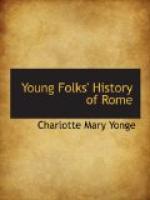[Illustration: Roman ensigns, standards, trumpets etc.]
Tarquin had lost all his sons, and died in wretched exile at Cumae. And here ends what is looked on as the legendary history of Rome, for though most of these stories have dates, and some sound possible, there is so much that is plainly untrue mixed up with them, that they can only be looked on as the old stories which were handed down to account for the Roman customs and copied by their historians.
CHAPTER VII.
The Roman government.
So far as true history can guess, the Romans really did have kings and drove them out, but there are signs that, though Porsena was a real king, the war was not so honorable to the Romans as they said, for he took the city and made them give up all their weapons to him, leaving them nothing but their tools for husbandry. But they liked to forget their misfortunes.
The older Roman families were called patricians, or fathers, and thought all rights to govern belonged to them. Settlers who came in later were called plebeians, or the people, and at first had no rights at all, for all the land belonged to the patricians, and the only way for the plebeians to get anything done for them was to become hangers-on—or, as they called it, clients—of some patrician who took care of their interests. There was a council of patricians called the Senate, chosen among themselves, and also containing by right all who had been chief magistrates. The whole assembly of the patricians was called the Comitia. They, as has been said before, fought on horseback, while the plebeians fought on foot; but out of the rich plebeians a body was formed called the knights, who also used horses, and wore gold rings like the patricians.
[Illustration: Head of Jupiter.]
But the plebeians were always trying not to be left out of everything. By and by, they said under Servius Tullius, the city was divided into six quarters, and all the families living in them into six tribes, each of which had a tribune to watch over it, bring up the number of its men, and lead them to battle. Another division of the citizens, both patrician and plebeian, was made every five years. They were all counted and numbered and divided off into centuries




